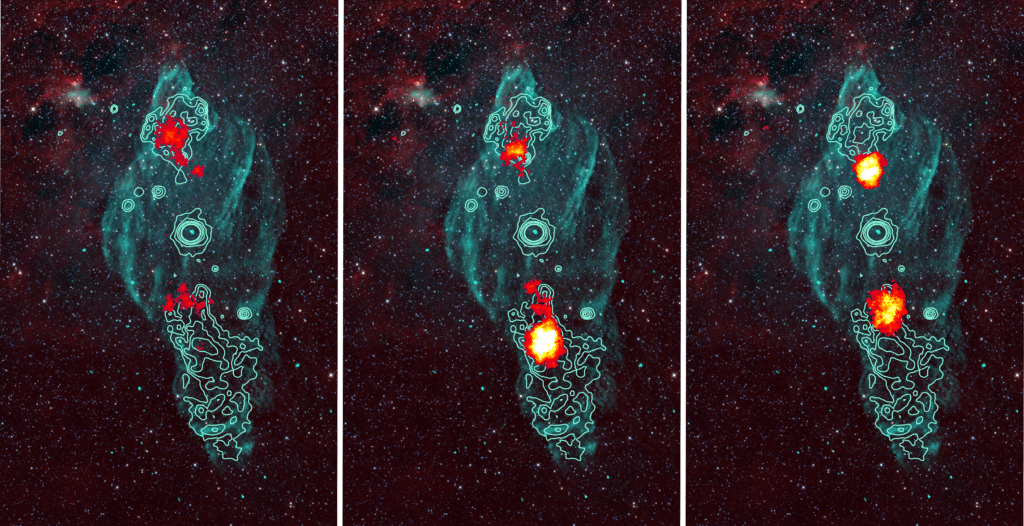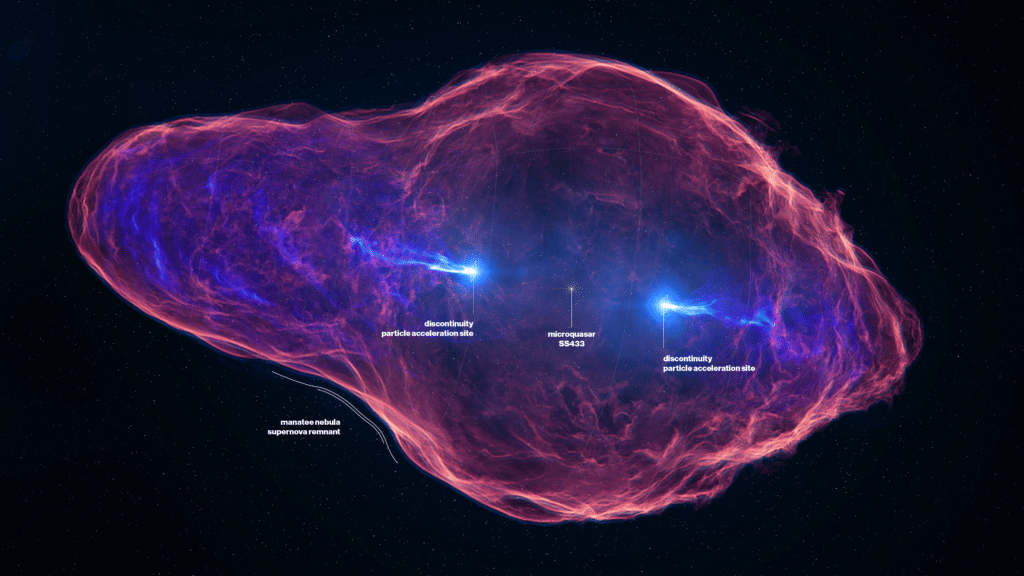Astronomers are attempting to solve a puzzle after making a significant discovery within a binary star system in the Milky Way galaxy. For the first time, scientists from the Max Plank Institute in Germany detected high-energy gamma rays emanating from the jets of SS 433, a unique object in space once highlighted by famed science fiction author Arthur C. Clarke as one of his seven wonders of the world. Known for its distinct X-ray emissions and its location at the center of the “manatee nebula,” SS 433 has revealed new secrets through recent studies.
SS 433 is a binary star system consisting of a black hole, about ten times the mass of the Sun, and a massive star. They orbit each other every 13 days, creating a dynamic interplay where the black hole strips material from the star, forming a hot gas disk. This process leads to the ejection of two plasma jets at high speeds.

What makes SS 433 extraordinary is the behavior of these jets. Initially detectable in various ranges, from radio to X-ray, these jets fade out but then, surprisingly, reappear as bright X-ray sources about 75 light-years from their origin. This puzzling phenomenon has been a subject of intrigue in the astronomical community.
Classified as a microquasar, SS 433 has similarities with the massive jets from the centers of active galaxies, like quasars. However, until 2018, there had been no detection of gamma-ray emissions from such a system. This changed with the High Altitude Water Cherenkov Gamma-ray Observatory (HAWC), which detected very-high-energy gamma rays from SS 433’s jets. This discovery was groundbreaking as it indicated that particles within these jets are being accelerated to extreme energies.
This close-up study of gamma-ray emissions from SS 433, which is in our Milky Way and thus closer and easier to observe, offers valuable insights into the dynamics of astrophysical jets. The H.E.S.S. Observatory furthered this research with an observation campaign resulting in 200 hours of data. This campaign achieved a milestone by not only confirming the gamma-ray emissions but also pinpointing their origin within the jets for the first time.

Researchers observed an energy-dependent shift in the position of the gamma-ray emission. High-energy gamma rays, over 10 teraelectron-volts, were detected at the point where the jets reappear as X-ray sources. Interestingly, gamma rays with lower energies were found further along the jets.
“This is the first-ever observation of energy-dependent morphology in the gamma-ray emission of an astrophysical jet,” says study author Laura Olivera-Nieto, from the Max-Planck-Institut für Kernphysik in Heidelberg, who was leading the H.E.S.S. study of SS 433 as part of her doctoral thesis, in a media release. “We were initially puzzled by these findings. The concentration of such high energy photons at the sites of the X-ray jets’ reappearance means efficient particle acceleration must be taking place there, which was not expected.”
Scientists simulated the observed energy dependence of the gamma-ray emission, estimating for the first time the velocity of the outer jets. They concluded that a strong shock, a sharp transition in medium properties, could be accelerating the particles and explaining the X-ray reappearance of the jets.
“When these fast particles then collide with a light particle (photon), they transfer part of their energy – which is how they produce the high-energy gamma photons observed with H.E.S.S. This process is called the inverse Compton effect,” explains Brian Reville, group leader of the Astrophysical Plasma Theory group at the Max Planck Institute for Nuclear Physics in Heidelberg.
Jim Hinton, director of the Max Planck Institute for Nuclear Physics, highlighted the significance of these findings.
“There has been a great deal of speculation about the occurrence of particle acceleration in this unique system – not anymore: the H.E.S.S. result really pins down the site of acceleration, the nature of the accelerated particles, and allows us to probe the motion of the large-scale jets launched by the black hole,” notes Hinton.
Despite these advancements, the origin of the shocks causing the jet re-emergence remains unknown. Researchers aim to focus on this aspect next, given SS 433’s relative proximity to Earth. This could offer insights into the behavior of much larger jets in active galaxies and quasars, potentially unraveling the mysteries of the most energetic cosmic rays.
The study is published in the journal Science.













